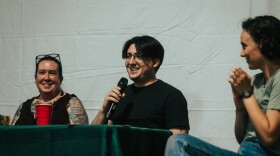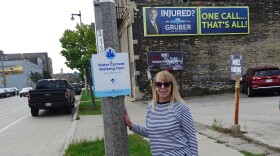A new state recreational area – called Sauk Prairie – is slowly taking shape in south central Wisconsin, south of Baraboo. Planning has been slow, partially because of the site’s unique history.

The public space will occupy about one-third of some 7,000 acres which for decades served as one of the world’s largest ammunition plants.
Despite that use, remnant woodlands and grasslands are considered to be exceptional resources.
The Department of Natural Resources drafted a master plan that incorporates restoration, and earlier this month held a public hearing.
Those who shared their views included:
Rob Nurre – Sauk Prairie Conservation Alliance President
The Alliance formed almost twenty years ago, when the Army announced it was going to decommission the ammo plant. “As soon as the word came out a group of people got together near Baraboo and began to plot an approach that would see to the preservation of this land,” Nurre says.
The Conservation Alliance wants to undertake expansive restoration. “It’s an incredibly fabulous opportunity to do a transition from oak forest of the Baraboo Hills through open oak woodlands, through prairie savanna into prairie itself, as you head down into what was originally known as Great Sauk Prairie - 14,000 acres of prairie on the flatland south of the Baraboo Bluffs,” he says.
As explained on the Wisconsin DNR’s website, the property has been divided into three parcels:
The property has a natural and human history that is significant on many scales. The former BAAP Badger Army Ammunition Plant) is, or will be, primarily owned by three parties: DNR (3,400 acres), Ho-Chunk Nation (1,600 acres) and Dairy Forage Research Center (2,100 acres), approximate acreages. Our master planning process focuses on the DNR-designated acreage.
The Alliance is urging the DNR to actively work with the Ho Chunk Nation and the Dairy Forage Research Center to as much as possible manage the land as one continuous whole.
Nurre says there is broad local support for the idea, and adds, his group supports silent sports, including hiking, bird watching, bicycling and snowshoeing

Frank Nobile - Tripoli Wisconsin Association High Power Rocketry President
Nobile's father used to take him out to shoot rockets when he was a boy. Later Nobile earned a Boy Scouts rocketry badge and years later, he helped his own sons with their rocketry badge.
Nobile says rocketry has become safer and more reliable. His club adheres to strict safety rules.
“Our club only allows a waiver of 10,000 feet. There is no limit on speed as long as it stays below the Federal Aviation Administration (FAA) waiver and we do get approval from the FAA based on where we launch and how far away we are from an airport. The landing zone has to be approved by the FAA,” he says.
Sauk Prairie would be the second state recreation area in Wisconsin in which rocketry would be allowed.
The DNR permitted rocketeers to use the Richard Bong State Recreation Area in 1994.

“We’ve been a very friendly user with all the people who use the park. We have good relationships with the dog people, the bikers, the hikers and the horse people. It has worked out very well. In fact, we’ve had some of those people joining us as spectators and they find it very fascinating,” Nobile says.
The DNR’s draft master plan allows for up to 10 days a year for rocketry events in Sauk Prairie Recreation.
“One advantage is that I’d like to have a foothold in central Wisconsin where somebody can launch a rocket safely in a controlled area where you know there aren’t going to be any power lines around, any rooftops around and no hazards to go chase after a rocket,” Nobile says.
He maintains rocketry is not harmful to the environment or to wildlife. “I know when we’ve launched in the past at Bong (State Recreation Area) we’ve had to stay out of certain areas where birds are nesting and we adjusted our venue for that day. We respect nature, wildlife and the land we use,” Nobile says.

Bryan Much - Off-Highway Motorcycle Advocate
Much says more than 245,000 Wisconsinites enjoy the sport, yet the state offers very few trails for them.
“Michigan has I think about 3500 miles of off-road vehicle trails, and of that 760 are dedicated to motorcycles only. In Wisconsin we have a little over 50 miles of motorcycle trails, so we’re really underserved,” Much says.
He says most of those trails are concentrated primarily in Jackson and Clark counties.
Much hoped the DNR master plan would dedicate trail exclusively to off-road motorcycles, instead it allows for dual-sport motorcycles for up to six days a year.
“You know two three-day weekends, it not what we want, it’s not what we need, but it’s certainly better than nothing,” Much says.
He says motorcycle riding is no harder on trail systems than horseback riding. Much says off highway motorcycle clubs pitch in to maintain trail systems.
“The clubs do brushing and take care of fallen trees on trails and if there’s a hotspot, like erosion, the clubs do the maintenance on it to take care of it. But over all the motorcycles are pretty light and they have a low impact. Actually there’s a study that compares it to horse trails and we’re pretty similar in terms of effect on the land,” Much says.

He applauds the DNR’s plans to restore the former ammo plant property, but believes recreation should be part of the restoration plan.
“You know, it is a recreation area and some people wrongly believe you can only have conservation restoration and not have recreation. There’s a mix of the two. You can have both,” Much says.
Much describes off highway motorcycling as motorized hiking.
“I was just up north this weekend. I had 133 mile ride through state and county forests. It’s very relaxing; you’re sightseeing; sometimes you see wildlife. It’s fun to operate the motorcycle on an uneven surface. The biggest thing is it takes you places people normally can’t get to,” he says.
Public comment on the Sauk Prairie Recreation Area Draft Master Plan is open until Friday, September 25.







